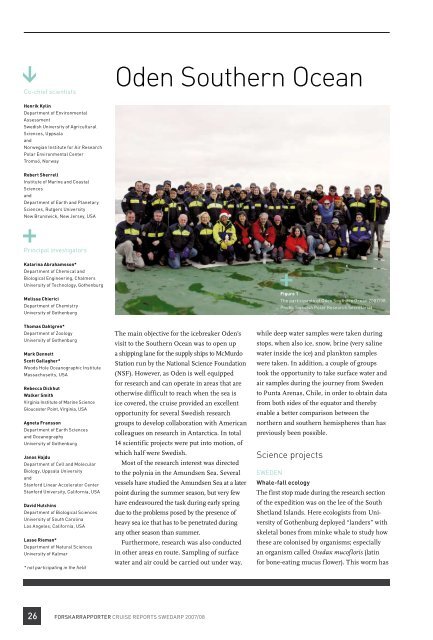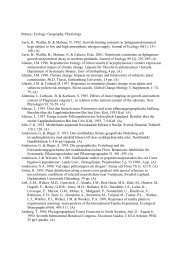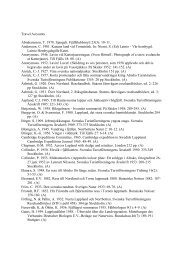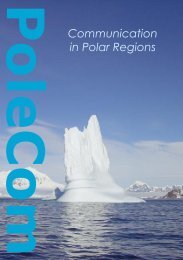Ladda ner årsbok 2008 (6,5 MB) - Polarforskningssekretariatet
Ladda ner årsbok 2008 (6,5 MB) - Polarforskningssekretariatet
Ladda ner årsbok 2008 (6,5 MB) - Polarforskningssekretariatet
You also want an ePaper? Increase the reach of your titles
YUMPU automatically turns print PDFs into web optimized ePapers that Google loves.
Co-chief scientists<br />
henrik Kylin<br />
Department of Environmental<br />
Assessment<br />
Swedish University of Agricultural<br />
Sciences, Uppsala<br />
and<br />
Norwegian Institute for Air Research<br />
Polar Environmental Center<br />
Tromsö, Norway<br />
Robert sherrell<br />
Institute of Marine and Coastal<br />
Sciences<br />
and<br />
Department of Earth and Planetary<br />
Sciences, Rutgers University<br />
New Brunswick, New Jersey, USA<br />
Principal investigators<br />
Katarina Abrahamsson*<br />
Department of Chemical and<br />
Biological Engineering, Chalmers<br />
University of Technology, Gothenburg<br />
melissa Chierici<br />
Department of Chemistry<br />
University of Gothenburg<br />
Thomas dahlgren*<br />
Department of Zoology<br />
University of Gothenburg<br />
mark dennett<br />
scott gallagher*<br />
Woods Hole oceanographic Institute<br />
Massachusetts, USA<br />
Rebecca dickhut<br />
Walker smith<br />
Virginia Institute of Marine Science<br />
Gloucester Point, Virginia, USA<br />
Agneta Fransson<br />
Department of Earth Sciences<br />
and oceanography<br />
University of Gothenburg<br />
Janos hajdu<br />
Department of Cell and Molecular<br />
Biology, Uppsala University<br />
and<br />
Stanford Linear Accelerator Center<br />
Stanford University, California, USA<br />
david hutchins<br />
Department of Biological Sciences<br />
University of South Carolina<br />
Los Angeles, California, USA<br />
lasse Rieman*<br />
Department of Natural Sciences<br />
University of Kalmar<br />
* not participating in the field<br />
oden southern ocean<br />
The main objective for the icebreaker Oden’s<br />
visit to the Southern Ocean was to open up<br />
a shipping lane for the supply ships to McMurdo<br />
Station run by the National Science Foundation<br />
(NSF). However, as Oden is well equipped<br />
for research and can operate in areas that are<br />
otherwise difficult to reach when the sea is<br />
ice covered, the cruise provided an excellent<br />
opportunity for several Swedish research<br />
groups to develop collaboration with American<br />
colleagues on research in Antarctica. In total<br />
14 scientific projects were put into motion, of<br />
which half were Swedish.<br />
Most of the research interest was directed<br />
to the polynia in the Amundsen Sea. Several<br />
vessels have studied the Amundsen Sea at a later<br />
point during the summer season, but very few<br />
have endeavoured the task during early spring<br />
due to the problems posed by the presence of<br />
heavy sea ice that has to be penetrated during<br />
any other season than summer.<br />
Furthermore, research was also conducted<br />
in other areas en route. Sampling of surface<br />
water and air could be carried out under way,<br />
26 FoRSKARRAPPoRTER CRUISE REPoRTS SWEDARP 2007/08<br />
Figure 1<br />
The participants of oden Southern ocean 2007/08.<br />
Photo: Swedish Polar Research Secretariat<br />
while deep water samples were taken during<br />
stops, when also ice, snow, brine (very saline<br />
water inside the ice) and plankton samples<br />
were taken. In addition, a couple of groups<br />
took the opportunity to take surface water and<br />
air samples during the journey from Sweden<br />
to Punta Arenas, Chile, in order to obtain data<br />
from both sides of the equator and thereby<br />
enable a better comparison between the<br />
northern and southern hemispheres than has<br />
previously been possible.<br />
Science projects<br />
SWEDEN<br />
Whale-fall ecology<br />
The first stop made during the research section<br />
of the expedition was on the lee of the South<br />
Shetland Islands. Here ecologists from University<br />
of Gothenburg deployed “landers” with<br />
skeletal bones from minke whale to study how<br />
these are colonised by organisms; especially<br />
an organism called Osedax mucofloris (latin<br />
for bone-eating mucus flower). This worm has








